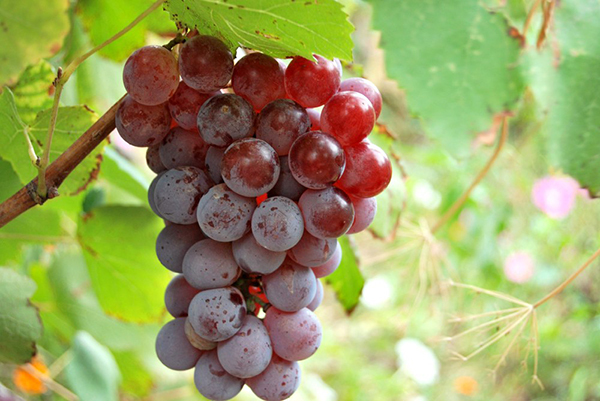Grapes Lydia won the love of winegrowers with its peculiar taste, ease of cultivation and care and versatility of use. From grapes of this variety they make an excellent wine with an exquisite taste, are consumed fresh, squeeze the juice and make compotes and jam. And besides lidia, wine can be obtained from excellent varieties - chardonnay and cabernet sauvignon.
Table of contents
Description and characteristic of a grade of a grade of a lidiya
Let's start with a description of the form.This variety appeared thanks to the work of breeders who planted on the wild grape variety Vitis labrusca, resistant to fungal diseases, the variety Vitis Vinifera. As a result, a new grape variety appeared, which immediately gained popularity in Europe, the Transcaucasus.
The grapes are resistant to temperatures as low as -20 degrees and have a strong immunity to fungal diseases. Belongs to mid-season varieties. The term of ripening fruits is 155–158 days. The bush is thickly growing, the vine is light brown in color. The leaves are green, weakly dissected, covered on the back side with a light felt down. The bush has 82% fruit-bearing shoots, giving 2 hands each. Mature brushes of a small size, the weight of each brush is 100-110 grams.
The shape of the brush is cylindrical, the density is friable. The berries are pink-purple, oval-circular in shape. The weight of each berry is from 3 to 4 grams. Berries have a wonderful aroma characteristic of this variety. The taste of sweet berries with strawberry flavor. The skin is dense. Contains 18-19% sugar.
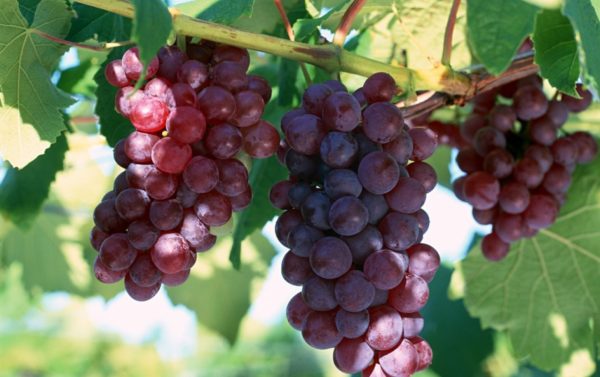
Advantages and disadvantages
The advantages of this variety are:
- high yield — 120 centners per hectare;
- self-pollination;
- high immunity to diseases;
- frost resistance property;
- berries are resistant to high humidity;
- suitable for transportation
- benefits to the human body.
Among the shortcomings of the variety include:
- lack of immunity against phylloxera lesion;
- with a low content of iron in the soil chlorosis develops;
- requires chasing and cracking;
- at late harvesting is subject to crumbling
- harm to the body when improperly prepared wine.
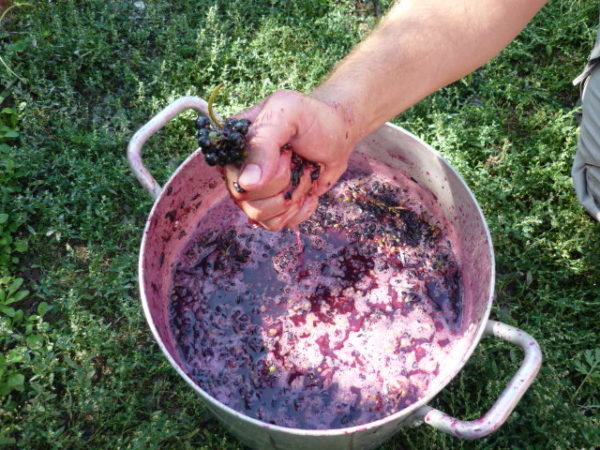
Features of growing
A place to grow this grape variety should be on the sunny side, evenly illuminated by rays from all sides. The vineyard must be protected from the wind, as the attachment of berries to the hand is weak and strong gusts of wind are able to shake off the ripe berries. The soil for growth should pass air and moisture well. However, the occurrence of groundwater should be at least 1.5 meters from the soil surface.Grows well on black and loamy soils.
Pits for planting grapes must be prepared in advance, as they have to stand for several weeks. If the spring planting, the pit can be prepared in the autumn. It is necessary to dig a hole with a diameter of 90 cm and a depth of 90 cm. Select the ground from the hole and pour clay into the bottom creating a drainage layer. To improve the soil for grapes in it you need to add:
- sifted river sand (if necessary);
- humus;
- ash;
- potassium;
- phosphorus;
- iron.
All components mix well with the ground, fall asleep in the pits and leave until spring. By the time of planting the ground will have time to settle well.
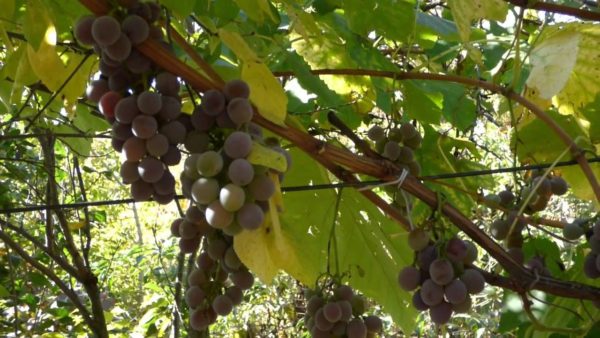
The seedling is buried in the soil to the root collar. It should remain on the surface. Land gently trampled down, well watered and mulched. Straw, sawdust or pine needles are well suited for mulching.
During the first months, frequent watering is necessary.Lydia loves moisture, but her stagnation should not be. After watering it is necessary to loosen the soil well.
Grape care
One of the activities for the care of grapes is chasing. This procedure consists in removing the upper part of the shoots up to 30 cm, with the presence on them of 6-8 not yet developed leaflets. Embossing is necessary for:
- ensure good penetration of light and air to the bushes, thereby reducing the risk of disease;
- redistribution of nutrients from processes to fruits;
- accelerating the ripening of vines and berries;
- yield increase;
- Suspension growth young shoots.
For Lydia, the optimal timing for minting is August.
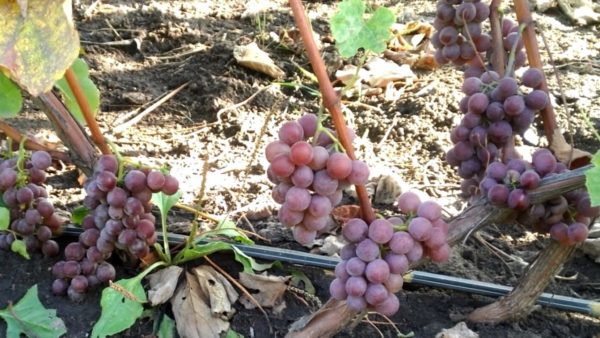
Mistakes made during stamping
The most common mistakes when performing minting:
- Chasing, carried out earlier than expected, at the stage of development of shoots leads to the fact that there is an incorrect distribution of nutrients. Begin to appear new shoots that need to break off, as this will increase the load on the bush.In this case, the vine will not be sufficiently strengthened, which will negatively affect the wintering of the plant.
Another negative consequence of early minting is the awakening of fruit buds, preserved until the new harvest. Instead of preparing for the winter, they begin to bloom.
- Chasing after the required period will have no effect., as the bush will cope with the task of redistributing nutrients by itself by stopping the process of maturing of new shoots.
- Not fully completed embossing, when not removed 30 cm. Vines and leaves leads to the fact that the leaves will continue to develop and take on the nutrients.
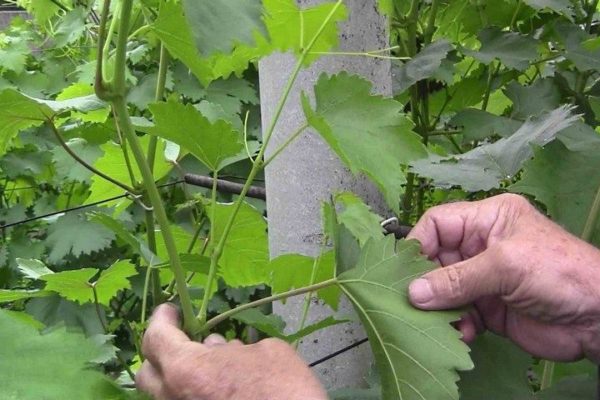
Breeding methods
The simplest and most common method of planting is planting seedlings. However, if there is a stock of an old bush, then it is better to vaccinate. To perform the inoculation, it is necessary to initially prepare the cutting, cutting it out from the escape of a bush of this variety, leaving 3 peepholes on it.
Until spring, the stalk is kept in the sand. The temperature at the storage location should be no higher than +12 degrees.Before inoculation, cut the lower part of the cutting. The upper part must be sealed with paraffin, so that the stalk loses less moisture and tolerates weather changes more easily. The bottom of the need to soak in the root growth stimulator.
Splitting the stock is possible only after the cut point has been cleaned and all rubbish has been removed. An incision is made in the middle, and a cutting is inserted into the slit.The shank is clamped by the stock. The vaccination site must be tied down with matter, which will decompose in a year. To keep the moisture longer, it is necessary to smear the place of the vaccination with clay and water it abundantly. Dig up the soil around and grind.
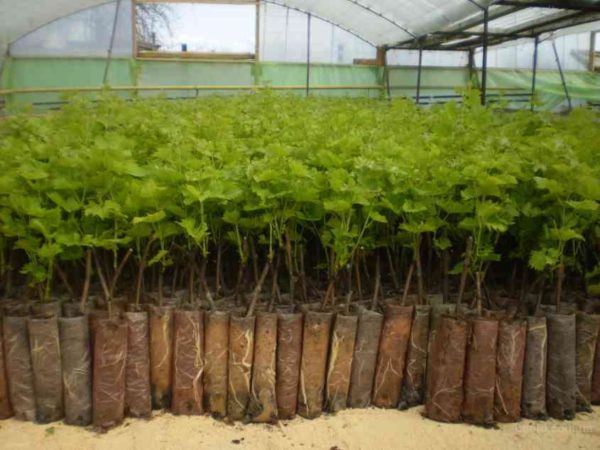
Diseases and pests
Lydia grapes prone to such diseases:
- anthracosis - A fungal disease that manifests itself by the appearance of black spots on leaves, vine, shoots. This disease destroys the vine. Infection occurs through the soil and seeds. In order to prevent removal of damaged areas and burn. Vine is treated with Bordeaux mixture;
- gray rot - A fungal disease affecting the entire vine. Occurs due to poor air access during thickening of the landing, or with abundant humidity. When infected, it is recommended to treat the bush with Ronilan.
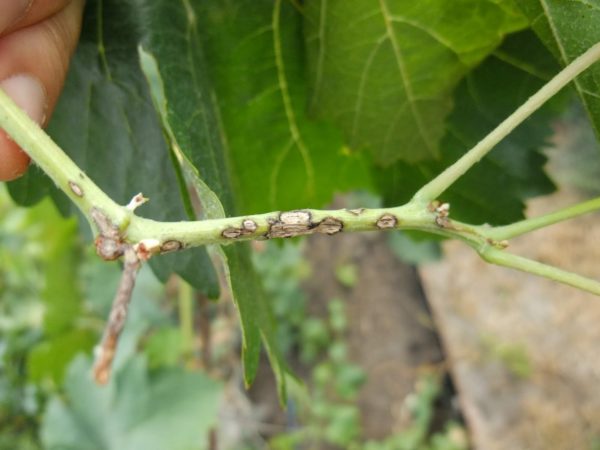
Lydia pests include:
- spider mite - damages the foliage and causes the fall. It is recommended to spray the bushes and soil with the drug "DNOC";
- leafworm - a caterpillar eating fruits and leaves, as a result of which the fruits rot in wet weather. When detected, the soil and bushes are treated with the drug "DNOC";
- phylloxera - an insect that infects the root of a plant, and sometimes leaves. To combat this insect treatment is necessary drug Confidor. The soil around the bushes fall asleep fine sand.
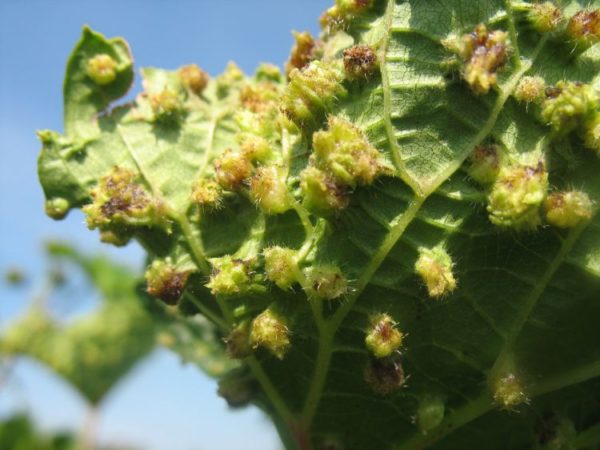
The grape variety Lydia is extremely popular in the south of Ukraine, Russia and in Moldova. He was loved for his unpretentious care, excellent taste and beautiful decorative appearance. Try to grow this variety on your site, and you will be provided with excellent wine, delicious compotes, juice and jam. You can also treat your guests with a fragrant bunch of fresh grapes.
